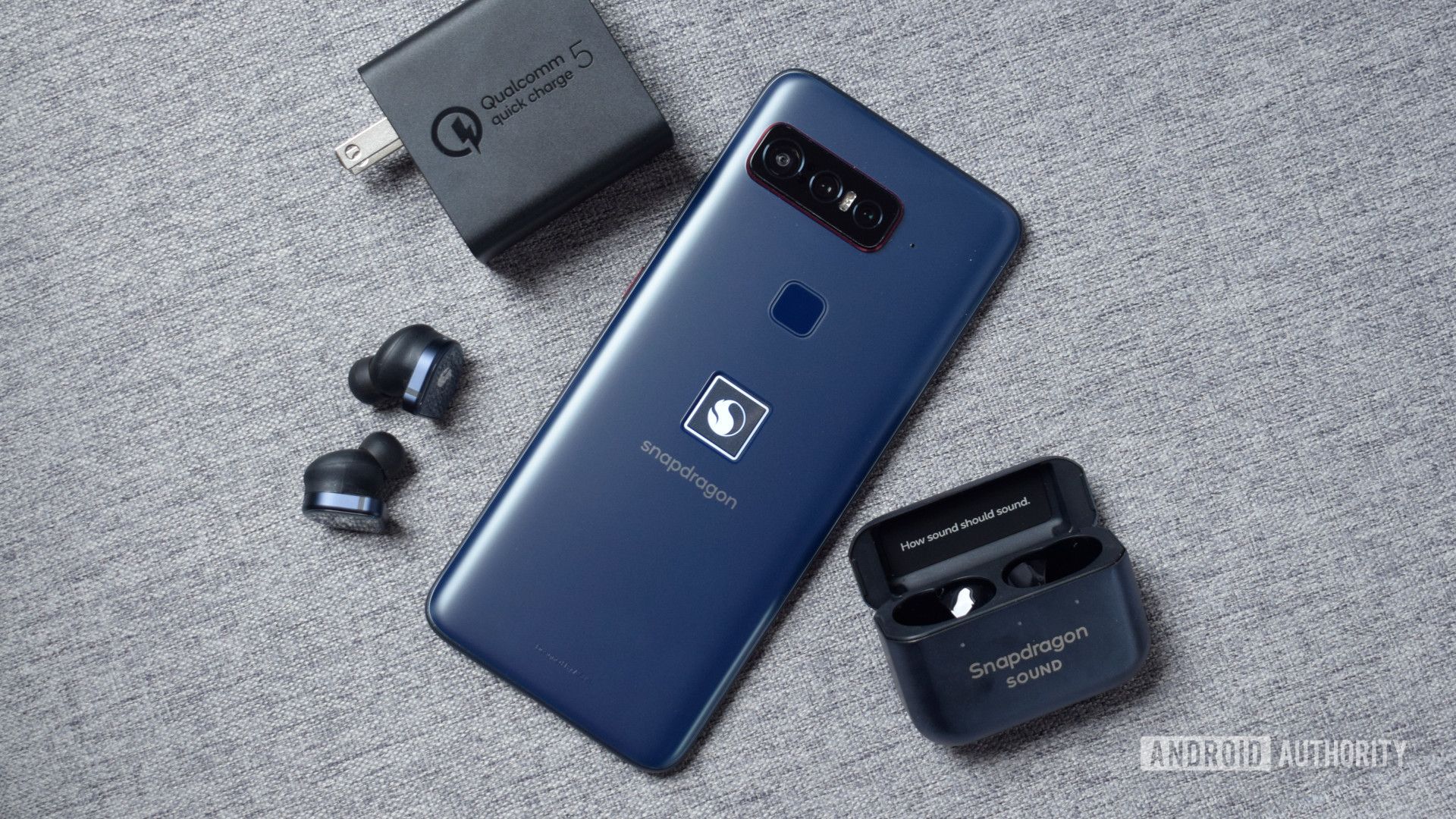What to expect from phones in 2024
Robert Triggs / Android Authority
Although the Snapdragon 8 Gen 2 is already powering some absolutely brilliant smartphones, we can’t help but think ahead to what the next generation will have to offer. Qualcomm will undoubtedly have a new chipset to power 2024 flagship smartphones, tentatively dubbed the Snapdragon 8 Gen 3.
Of course, Qualcomm keeps the details of its upcoming chipset tightly under wraps until its official unveiling. Still, we can glean a bit about what to expect based on information and rumors currently dotted around the web.
Will there be a Snapdragon 8 Gen 3 processor, and when will it arrive? As far as we know, Qualcomm isn’t planning to bow out of the highly lucrative mobile SoC business, so a Snapdragon 8 Gen 3 is undoubtedly on the cards. The rumor mill has already spotted references to the chip, which apparently bears the SM8650 model number.
Qualcomm typically announced its next-gen processor products at Snapdragon Tech Summit. The exact dates vary a little each year. Still, we can expect the event to occur in October or November 2023, when we will see the Snapdragon 8 Gen 3 announced and the company’s highly anticipated Oryon CPU for PC products.
What features will the Snapdragon 8 Gen 3 have?
Qualcomm
Despite Qualcomm keeping details on its next-generation flagship processor under lock and eye, that hasn’t stopped the rumor mill churning out a few potential specifications. Combined with various industry announcements, such as new CPUs from Arm and Bluetooth standards from SIG, we can already put a few pieces of the puzzle together.
64-bit only this time According to the latest Snapdragon 8 Gen 3 rumors, Qualcomm is preparing to drop 32-bit support. Finally.
The Android ecosystem has been moving towards 64-bit-only support for several years now. The Play Store only serves 64-bit apps to compatible devices as of August 2021. Chip IP giant Arm even dropped 32-bit support from most of its CPU roadmap before reversing course by introducing the capabilities as an option for its little Cortex-A510 cores.
To please hold outs (mainly in the Chinese market), the Snapdragon 8 Gen 2 ended up with an odd CPU layout featuring both 64-bit only and 32-bit capable CPU cores. The 1+2+2+3 design was a departure from previous Snapdragon CPU setups, and one that Qualcomm won’t necessarily have to revisit if it moves over to 64-bit only.
The latest Arm Cortex CPUs
Arm
Such a rumor gels with what we know about the latest Arm CPUs, which are almost certain to power the Snapdragon 8 Gen 3. Arm’s latest Cortex-X4, A720, and A520 CPUs are 64-bit only, so using these cores rules out 32-bit support. Arm IP seems likely once more, as Oryon, Qualcomm’s custom Arm-based core design, is expected to debut in laptops before being distilled down to the smartphone form factor.
Still, rumors hint at a rather intriguing 1+2+3+2 CPU setup. Apparently, this consists of one Cortex-X core (presumably the X4), two A-5XX class cores (the new A520?), and five A7XX cores split into groups of two and three.
Rather than featuring 32-bit cores, which isn’t possible in combination with the new ARMv9 CPUs, Qualcomm could implement the Cortex-A720 middle cores across two different performance points. Two cores with larger caches and clock speeds, paired with three smaller configurations would increase the SoC’s capability to scale up smoothly and down the performance/power curve. Moving to just two power-efficient cores would also be an interesting choice, and increasingly energy-economical mid-cores make large little core counts less of a necessity in modern chipsets.
AI will play a big part
Robert Triggs / Android Authority
AI is 2023’s big buzzword and one that probably won’t be going away anytime soon. Of course, smartphones are already jammed-packed with machine learning number-crunching capabilities, but scaling advanced AI models to run on-device is a looming challenge. In May 2023, Qualcomm published a whitepaper focusing on the future of hybrid AI — running both in the cloud and on-device.
While primarily highlighting the work Qualcomm already has in place with its AI Engine and developer ecosystem (likely to keep itself in the discussion), it’s a reminder that AI is vital to Qualcomm’s Snapdragon platforms. Given today’s headwinds, AI is sure to be even more prominent in the coming years.
As to precisely what to expect regarding AI improvements, we’ll have to wait for the summit. A safe bet would be beefed-up capabilities to support compressed AI models. We’ve already seen Stable Diffusion running on a demo device, albeit with reduced capabilities. The Snapdragon 8 Gen 2 already supports INT4, which is as small as ML models go. Instead, tighter integration between Qualcomm’s Spectra ISP, Hexagon DSP, and Adreno GPU may also be crucial to achieving extra performance.
Connected to the hilt
C. Scott Brown / Android Authority
The Snapdragon 8 Gen 3 wouldn’t be complete without a considerable connectivity suite, and we’re expecting the latest and greatest here.
Qualcomm’s existing chipset may already have hit the home network ceiling with early support for Wi-Fi 7, but compliance with the final spec will likely appear in the 8 Gen 3. Furthermore, a new Snapdragon X75 5G modem promises a smaller area footprint, up to 20% power savings over the X70, and improved location accuracy with GNSS Location Gen 2 that are destined for Qualcomm’s next flagship chip.
The latest Bluetooth 5.4 standard is also an option. While not game-changing from an end-user perspective, Periodic Advertising with Responses synchronizes packet communication to improve power efficiency in ultra-low power use cases. Meanwhile, Encrypted Advertising Data standardizes advertisement traffic encryption to ensure secure IoT systems. Audio enthusiasts can expect to be treated to Qualcomm’s Dynamic Spatial Audio and Snapdragon Sound benefits.
What we want to see from the Snapdragon 8 Gen 3
Robert Triggs / Android Authority
The Snapdragon 8 Gen 2 is a great chip, but there are a few specific improvements we’d like to see with Qualcomm’s looming announcement.
Even better-sustained performance With the Samsung 4nm fiasco firmly in the rearview mirror, 2023 smartphones have been reasonably free from performance throttling issues. Still, we’ve seen the occasionally hot handset and brands that scale back everyday performance in pursuit of multi-day battery life. The holy grail is a chip that provides peak performance without holding back for fear of high temps or battery drain. Hopefully, the Snapdragon 8 Gen 3 can be that chip.
Sustained performance has been more concerning when looking at longer-term gaming performance. Our in-house gaming test shows that a hefty cooling solution is still required to lock a rock-solid 60fps over moderate play times. The higher GPU clock speed of the Snapdragon 8 Gen 2 for Galaxy doesn’t translate into a better gaming experience once you surpass the five-minute mark.
Thankfully, efficiency gains from new CPU cores and smaller 3nm manufacturing nodes mean more efficient chips are possible. Just as long as Qualcomm doesn’t get caught up chasing unsustainable peak performance.
More powerful ray tracing capabilities Speaking of graphics, ray tracing may still be a mobile graphics niche (in fact, there aren’t any Western games at the time of writing), but we fully expect the Snapdragon 8 Gen 3 to keep this functionality from its processor. That said, Qualcomm’s first-gen attempt at mobile ray tracing was underwhelming when we benchmarked the chip’s capabilities.
Qualcomm’s Adreno 740 came in well behind Arm’s Immortalis G715 architecture found in the MediaTek Dimensity 9200, and Arm’s architecture will see some future gains in the new Immortalis G720 GPU. The Snapdragon 8 Gen 2 scored behind 2022’s Exynos 2200 and its AMD Xclipse graphics chip in Basemark’s InVitro test too.
While not essential, we would like to see ray tracing improvements with the Snapdragon 8 Gen 3’s GPU to keep the chip future-proof for when this demanding graphics technology becomes mainstream.
Prices that won’t break the bank While Qualcomm doesn’t disclose partner pricing, we know that the latest and greatest processor technology doesn’t come cheap and is a notable cost on a smartphone bill of materials. The Snapdragon 8 Gen 3 shouldn’t be cheap, especially given the articles on this wishlist, but we’d like to see value for money in terms of features that consumers benefit from most.
This is especially important given that there are some great value chipsets already on the market. Even in Qualcomm’s own portfolio, the Snapdragon 7 Plus Gen 2 compares very favorably against flagship processors from less than two years ago. And we certainly didn’t have any complaints about smartphones powered by the 8 Plus Gen 1.
Flagship smartphone prices are already steep in today’s economy; one less reason to increase prices further would be very welcome. There’s plenty to look forward to with the Snapdragon 8 Gen 3, which will power flagship smartphones launching in early 2024. Of course, Qualcomm isn’t the only company expected to unveil new silicon later this year. We’re equally excited to see what Google has in store with the Tensor G3 too.
What do you most want from the Snapdragon 8 Gen 3 processor? 69 votes Improved battery life 68 % Better sustained gaming performance 22 % Enhanced AI smarts 7 % Leveled-up ray tracing 3 %
Comments
Source: Android Authority


